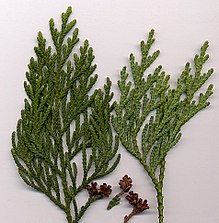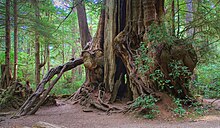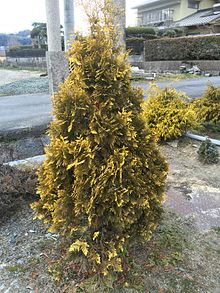| Thuja | |
|---|---|

| |
| Thuja standishii foliage and cones | |
| Scientific classification | |
| Kingdom: | Plantae |
| Clade: | Tracheophytes |
| Clade: | Gymnospermae |
| Division: | Pinophyta |
| Class: | Pinopsida |
| Order: | Cupressales |
| Family: | Cupressaceae |
| Subfamily: | Cupressoideae |
| Genus: | Thuja L. |
| Type species | |
| Thuja occidentalis L. | |
Thuja (/ˈθjuːdʒə/ THEW-jə) is a genus of coniferous tree or shrub in the Cupressaceae (cypress family). There are five species in the genus, two native to North America and three native to eastern Asia. The genus is monophyletic and sister to Thujopsis. Members are commonly known as arborvitaes (from the Latin term for 'tree of life'), thujas or cedars.
Description

Thuja are evergreen trees growing from 10 to 200 feet (3 to 61 metres) tall, with stringy-textured reddish-brown bark. The shoots are flat, with side shoots only in a single plane. The leaves are scale-like and 1 to 10 mm (0.039 to 0.394 in) long, except young seedlings in their first year, which have needle-like leaves. The scale leaves are arranged in alternating decussate pairs in four rows along the twigs. The male cones are small, inconspicuous, and are located at the tips of the twigs. The female cones start out similarly inconspicuous, but grow to about 1 to 2 cm (0.39 to 0.79 in) long at maturity when 6–8 months old; they have 6-12 overlapping, thin, leathery scales, each scale bearing 1–2 small seeds with a pair of narrow lateral wings.
The five species in the genus Thuja are small to large evergreen trees with flattened branchlets. The leaves are arranged in flattened fan shaped groupings with resin-glands, and oppositely grouped in 4 ranks. The mature leaves are different from younger leaves, with those on larger branchlets having sharp, erect, free apices. The leaves on flattened lateral branchlets are crowded into appressed groups and scale-like and the lateral pairs are keeled. With the exception of T. plicata, the lateral leaves are shorter than the facial leaves (Li et al. 2005). The solitary flowers are produced terminally. Pollen cones with 2-6 pairs of 2-4 pollen sacked sporophylls. Seed cones are ellipsoid, typically 9 to 14 mm (0.35 to 0.55 in) long, and mature and open the first year. The thin woody cone scales number from 4-6 pairs and are persistent and overlapping, with an oblong shape, they are also basifixed. The central 2-3 pairs of cone scales are fertile. The seed cones produce 1 to 3 seeds per scale, the seeds are lenticular in shape and equally 2 winged. Seedlings produce 2 cotyledons.




A hybrid between T. standishi and T. plicata has been named as the cultivar Thuja 'Green Giant'.
Another very distinct and only distantly related species, formerly treated as Thuja orientalis, is now treated in a genus of its own, as Platycladus orientalis. The closest relatives of Thuja are Thujopsis dolabrata, distinct in its thicker foliage and stouter cones, and Tetraclinis articulata (Ancient Greek θυία or θύα, formerly classed in the genus and after which Thuja is named), distinct in its quadrangular foliage (not flattened) and cones with four thick, woody scales.
The genus Thuja, like many other forms of conifers, is represented by ancestral forms in Cretaceous rocks of northern Europe, and with the advance of time is found to migrate from northerly to more southerly regions, until during the Pliocene period, when it disappeared from Europe. Thuja is also known in the Miocene beds of the Dakotas.
Taxonomy
Phylogeny
| Stull et al. 2021 | |||||||||||||||||||||||||||
|---|---|---|---|---|---|---|---|---|---|---|---|---|---|---|---|---|---|---|---|---|---|---|---|---|---|---|---|
|
Species
The five extant species are:
| Image | Scientific name | Common Name | Distribution |
|---|---|---|---|
 |
Thuja koraiensis Nakai | Korean thuja | Jilin, Korea |
 |
Thuja occidentalis L. | eastern arborvitae, northern whitecedar | E Canada (Manitoba to Nova Scotia), E United States (primarily Northeast, Great Lakes, Appalachians) |
 |
Thuja plicata Donn ex D.Don | western redcedar | from Alaska to Mendocino County in California |
 |
Thuja standishii (Gordon) Carrière | Japanese thuja | Honshu, Shikoku |
| Thuja sutchuenensis (Gordon) Carrière | Sichuan thuja | Sichuan, Chongqing China almost extinct in the wild |
Species formerly placed in Thuja include:
- Austrocedrus chilensis (D.Don) Pic.Serm. & Bizzarri (as T. chilensis D.Don)
- Callitris rhomboidea R.Br. ex Rich. (as T. australis Poir.)
- Cupressus nootkatensis D.Don (as T. excelsa Bong.)
- Dacrycarpus imbricatus (Blume) de Laub (as T. javanica Burm.f.)
- Glyptostrobus pensilis (Staunton ex D.Don) K.Koch (as T. pensilis Staunton ex D.Don)
- Libocedrus plumosa (D.Don) Sarg. (as T. doniana Hook.)
- Platycladus orientalis (L.) Franco (as T. orientalis L.)
- Tamarix aphylla (L.) H.Karst. (as T. aphylla L.)
- Tetraclinis articulata (Vahl) Mast. (as T. articulata Vahl)
- Thujopsis dolabrata (Thunb. ex L.f.) Siebold & Zucc. (as T. dolabrata Thunb. ex L.f.)
- Widdringtonia nodiflora (L.) Powrie (as T. cupressoides L.)
and many more
The extant species Thuja sutchuenensis was believed to be extinct until 1999, when a small population was discovered in southeast China.
Ecology
Thuja species are used as food plants by the larvae of some Lepidoptera species including autumnal moth, the engrailed and juniper pug. The foliage is also readily eaten by deer, and where deer population density is high, can adversely affect the growth of young trees and the establishment of seedlings.
Distribution
The genus Thuja has current populations in both North America and East Asia. T. plicata has wide distribution in the Pacific Northwest from Northern California to Alaska, reaching East into Idaho and central British Columbia. T. occidentalis has populations in the Northeastern United States, reaching north into Ontario and Quebec, with some distribution as far south as Tennessee.
T. standishii has populations in mountainous regions of Honshu and Shikoku islands in Japan, with no recorded population in the north of the country. T. koraiensis is native to both North and South Korea and has a small population in the Northern Chinese province of Jilin. The newly rediscovered species T. sutchuenensis has extremely limited distribution in the mountains of Chengkou county in southeastern China.
Evolution and paleobiogeography
Current research suggests that Thuja originated in the Americas and migrated to East Asia via the Bering land bridge in the Miocene. Fossil records show that Thuja was significantly more widely distributed during the late Cretaceous and early Tertiary than we see today. The oldest known Thuja fossil is of T. polaris (an extinct species) from the Paleocene of Ellesmere Island in present-day Nunavut, Canada.
Other hypotheses of Thuja origin involved an East Asian origin, with the genus migrating twice; once east into North-western America and then west to the North-eastern America, but since no reliable fossil records of Thuja exist in either Western Asia or Europe, the possibility can be eliminated.
Systematics
Thuja is a monophyletic genus that sits within the order Pinales in the Cupressaceae. Thuja is in the Cupressoid clade and is sister to the genus Thujopsis. The sister relationship between Thuja and Thujopsis is supported with 100% bootstrap support and 1.0 posterior probability.
Within the genus the taxonomy is in flux, but most recent research based on molecular analysis of plastomes in the genus Thuja showed evidence for a new grouping, with two sister clades: T. standishii and T. koraiensis together and T. occidentalis and T. sutchuenensis together, with T. plicata sister to T. occidentails and T. sutchuenensis. This newest grouping is hypothesized to be the result of reticulate evolution and hybridization within the genus.
Uses of thuja
They are widely grown as ornamental trees, and extensively used for hedges. A number of cultivars are grown and used in landscapes. Homeowners will sometimes plant them as privacy trees. The cultivar 'Green Giant' is popular as a very vigorous hedging plant, growing up to 80 cm/year when young.
The wood is light, soft and aromatic. It can be easily split and resists decay. The wood has been used for many applications from making chests that repel moths to shingles. Thuja poles are also often used to make fence posts and rails. The wood of Thuja plicata is commonly used for guitar sound boards. Its combination of light weight and resistance to decay has also led to T. plicata being widely used for the construction of bee hives.
T. plicata is an important tree to the First Nations people of the Pacific Northwest and is sometimes called "Canoe Tree" because of its use as a material for Native American canoes.
Oil of Thuja contains the terpene thujone which has been studied for its GABA receptor antagonizing effects, with potentially lethal properties. Cedarwood oil and cedar leaf oil, which are derived from Thuja occidentalis, have different properties and uses.
The natives of Canada used the scaled leaves of Thuja occidentalis to make a tea that has been shown to contain 50 mg of vitamin C per 100 grams; this helped prevent and treat scurvy.
In the 19th century, Thuja was commonly used as an externally applied tincture or ointment for the treatment of warts, ringworm and thrush, and a local injection of the tincture was used for treating venereal warts.
A 2017 trial showed that its extract effectively killed both gram-positive and gram-negative bacteria.
As with many Cupressaceae, Thuja can induce allergic reactions, including skin, eye and breathing problems.
References
- Sunset Western Garden Book, 1995:606–607
"Thuja". Oxford English Dictionary (Online ed.). Oxford University Press. (Subscription or participating institution membership required.) - ^ "Thuja". Plants of the World Online. Royal Botanic Gardens, Kew. Retrieved 21 August 2024.
- ^ Farjon, A. (2005). Monograph of Cupressaceae and Sciadopitys. Kew: Royal Botanic Gardens. ISBN 978-1-84246-068-9.
- Earle, Christopher J., ed. (2018). "Thuja". The Gymnosperm Database.
- Fu, Liguo; Yu, Yong-fu; Adams, Robert P.; Farjon, Aljos. "Thuja". Flora of China. Vol. 4 – via eFloras.org, Missouri Botanical Garden, St. Louis, MO & Harvard University Herbaria, Cambridge, MA.
- NRCS. "Thuja". PLANTS Database. United States Department of Agriculture (USDA). Retrieved 9 December 2015.
- Chambers, Kenton L. (1993). "Thuja". In Flora of North America Editorial Committee (ed.). Flora of North America North of Mexico (FNA). Vol. 2. New York and Oxford: Oxford University Press – via eFloras.org, Missouri Botanical Garden, St. Louis, MO & Harvard University Herbaria, Cambridge, MA.
- Gleason, Henry A. New Britton and Brown Illustrated Flora of Eastern North America and Adjacent Canada. Vol. 1: The Pteridophya, Gymnospermae and Monocotyledoneae. Hafner Press. pp. 58–67.
{{cite encyclopedia}}: Missing or empty|title=(help) - Gilman, D. C.; Peck, H. T.; Colby, F. M., eds. (1905). "Arbor Vitæ" . New International Encyclopedia (1st ed.). New York: Dodd, Mead.
- Stull, Gregory W.; Qu, Xiao-Jian; Parins-Fukuchi, Caroline; Yang, Ying-Ying; Yang, Jun-Bo; Yang, Zhi-Yun; Hu, Yi; Ma, Hong; Soltis, Pamela S.; Soltis, Douglas E.; Li, De-Zhu; Smith, Stephen A.; Yi, Ting-Shuang; et al. (2021). "Gene duplications and phylogenomic conflict underlie major pulses of phenotypic evolution in gymnosperms". Nature Plants. 7 (8): 1015–1025. Bibcode:2021NatPl...7.1015S. bioRxiv 10.1101/2021.03.13.435279. doi:10.1038/s41477-021-00964-4. PMID 34282286. S2CID 232282918.
- Stull, Gregory W.; et al. (2021). "main.dated.supermatrix.tree.T9.tre". Figshare. doi:10.6084/m9.figshare.14547354.v1.
{{cite journal}}: Cite journal requires|journal=(help) - "GRIN Species Records of Thuja". Germplasm Resources Information Network. United States Department of Agriculture. Retrieved 2013-01-22.
- "Thuja". County-level distribution maps from the North American Plant Atlas (NAPA). Biota of North America Program (BONAP). 2014.
- "WCSP, the last web-archive snapshot before migration to POWO (Archive copy)". 2022-10-20. Archived from the original on 2022-10-20.
- Qiaoping, Xiang; Fajon, A.; Zhenyu, Li; Likuo, Fu; Zhengyu, Liu (2002-07-01). "Thuja sutchuenensis: a rediscovered species of the Cupressaceae". Botanical Journal of the Linnean Society. 139 (3): 305–310. doi:10.1046/j.1095-8339.2002.00055.x. ISSN 0024-4074.
- Stein, W. I. (1997). "Ten-year survival and growth of planted Douglas-fir and western redcedar after seven site-preparation treatments". Western Journal of Applied Forestry. 12 (3): 74–80. doi:10.1093/wjaf/12.3.74.
- Cowley, Jill; Zheng-yi, Wu; Raven, Peter H. (1997). "Flora of China Volume 15, Myrsinaceae through Loganiaceae". Kew Bulletin. 52 (3): 765. Bibcode:1997KewBu..52..765C. doi:10.2307/4110318. ISSN 0075-5974. JSTOR 4110318.
- ^ Cui, Yi-Ming; Sun, Bin; Wang, Hai-Feng; Ferguson, David Kay; Wang, Yu-Fei; Li, Cheng-Sen; Yang, Jian; Ma, Qing-Wen (2015-09-22). "Exploring the Formation of a Disjunctive Pattern between Eastern Asia and North America Based on Fossil Evidence from Thuja (Cupressaceae)". PLOS ONE. 10 (9): e0138544. Bibcode:2015PLoSO..1038544C. doi:10.1371/journal.pone.0138544. ISSN 1932-6203. PMC 4579098. PMID 26393513.
- Peng, Dan; Wang, Xiao-Quan (June 2008). "Reticulate evolution in Thuja inferred from multiple gene sequences: Implications for the study of biogeographical disjunction between eastern Asia and North America". Molecular Phylogenetics and Evolution. 47 (3): 1190–1202. Bibcode:2008MolPE..47.1190P. doi:10.1016/j.ympev.2008.02.001. ISSN 1055-7903. PMID 18346917.
- ^ Adelalu, Kole F.; Zhang, Xu; Qu, Xiaojian; Landis, Jacob B.; Sun, Yanxia; Meng, Aiping; Sun, Hang; Wang, Hengchang (2019-08-30). "Plastome phylogenomic and biogeographic study on Thuja (Cupressaceae)". doi:10.21203/rs.2.13750/v1.
{{cite journal}}: Cite journal requires|journal=(help) - Brand, Mark H. (2001). "Thuja plicata". UConn Plant Database. University of Connecticut. Archived from the original on 2007-10-29.
- Brand, Mark H. (2001). "Thuja occidentalis". UConn Plant Database. University of Connecticut. Archived from the original on 2007-10-21.
- "U.S. National Arboretum: Gardens: FAQs: 'Green Giant' Arborvitae". Archived from the original on 2013-01-27. Retrieved 2008-01-23.
- Bucur, Voichita (1995). "Acoustics of wood". Boca Raton: CRC Press.
{{cite web}}: Missing or empty|url=(help) - Owano, Nacy. "Flow Hive 2 sees sweet success in offering new features for honey on tap". Tech Xplore. Retrieved 15 October 2022.
- Höld KM, Sirisoma NS, Ikeda T, Narahashi T, Casida JE (2000). "Alpha-thujone (the active component of absinthe): gamma-aminobutyric acid type A receptor modulation and metabolic detoxification". Proc. Natl. Acad. Sci. U.S.A. 97 (8): 3826–31. Bibcode:2000PNAS...97.3826H. doi:10.1073/pnas.070042397. PMC 18101. PMID 10725394.
- "Cedarwood Oil Vs Cedar Leaf Oil". Cedar Leaf Canada. Retrieved 16 June 2015.
- Johnston, William F. (1990). "Thuja occidentalis". In Burns, Russell M.; Honkala, Barbara H. (eds.). Conifers. Silvics of North America. Vol. 1. Washington, D.C.: United States Forest Service (USFS), United States Department of Agriculture (USDA) – via Southern Research Station.
- Hoffmann, David (2003). Medical Herbalism: Principles and Practices. Healing Arts Press. p. 588. ISBN 978-0-89281-749-8.
- Grieve, M. (1931). A Modern Herbal. London: Jonathan Cape. p. 177.
- Sah, Shiv Nandan; Regmi, Sunil; Tamang, Man Kumar (2017-06-29). "Antibacterial Effects of Thuja Leaves Extract". International Journal of Applied Sciences and Biotechnology. 5 (2): 256–260. doi:10.3126/ijasbt.v5i2.17617. ISSN 2091-2609.
External links
- "Arbor Vitæ" . Encyclopedia Americana. 1920.
| Classification of Acrogymnospermae (living Gymnosperms) | |||||||||||||||||||||||||||||||||||||||||||||||||||||||||||||||||||||||||||
|---|---|---|---|---|---|---|---|---|---|---|---|---|---|---|---|---|---|---|---|---|---|---|---|---|---|---|---|---|---|---|---|---|---|---|---|---|---|---|---|---|---|---|---|---|---|---|---|---|---|---|---|---|---|---|---|---|---|---|---|---|---|---|---|---|---|---|---|---|---|---|---|---|---|---|---|
| |||||||||||||||||||||||||||||||||||||||||||||||||||||||||||||||||||||||||||
| Taxon identifiers | |
|---|---|
| Thuja |
|